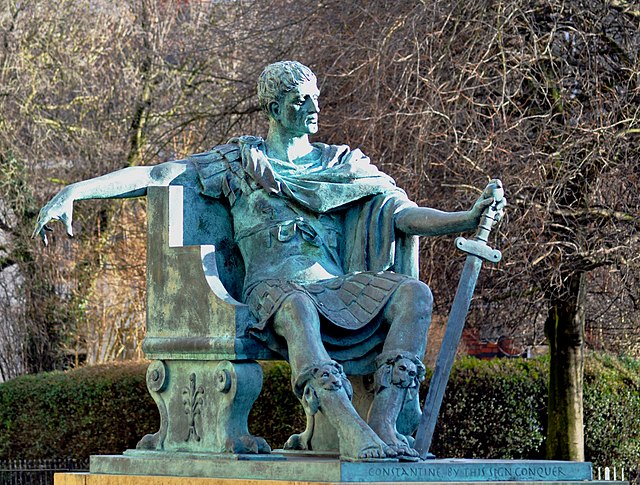The Visigoths were a Germanic people united under the rule of a king and living within the Roman Empire during late antiquity. The Visigoths first appeared in the Balkans, as a Roman-allied barbarian military group united under the command of Alaric I. Their exact origins are believed to have been diverse but they probably included many descendants of the Thervingi who had moved into the Roman Empire beginning in 376 and had played a major role in defeating the Romans at the Battle of Adrianople in 378. Relations between the Romans and Alaric's Visigoths varied, with the two groups making treaties when convenient, and warring with one another when not. Under Alaric, the Visigoths invaded Italy and sacked Rome in August 410.
The eagles represented on these fibulae from the 6th century, and found in Tierra de Barros (Badajoz), were a popular symbol among the Goths in Spain.
Detail of the votive crown of Recceswinth from the Treasure of Guarrazar (Toledo, Spain), hanging in Madrid. The hanging letters spell [R]ECCESVINTHVS REX OFFERET [King R. offers this].
Gutthiuda[citation needed]
Migrations of the main column of the Visigoths
Late antiquity is sometimes defined as spanning from the end of classical antiquity to the local start of the Middle Ages, from around the late 3rd century up to the 7th or 8th century in Europe and adjacent areas bordering the Mediterranean Basin depending on location. The popularisation of this periodization in English has generally been credited to historian Peter Brown, who proposed a period between 150–750 AD. The Oxford Centre for Late Antiquity defines it as "the period between approximately 250 and 750 AD". Precise boundaries for the period are a continuing matter of debate. In the West, its end was earlier, with the start of the Early Middle Ages typically placed in the 6th century, or even earlier on the edges of the Western Roman Empire.
The Barberini ivory, a late Leonid/Justinian Byzantine ivory leaf from an imperial diptych, from an imperial workshop in Constantinople in the first half of the sixth century (Louvre Museum)
Late 4th-century Roman bust of a Germanic slave in Augusta Treverorum (Trier) in Belgica Prima, seat of the praetorian prefecture of Gaul (Rheinisches Landesmuseum Trier)
Modern statue of Constantine I at York, where he was proclaimed Augustus in 306
The Favourites of the Emperor Honorius, 1883: John William Waterhouse expresses the sense of moral decadence that coloured the 19th-century historical view of the 5th century.


![Detail of the votive crown of Recceswinth from the Treasure of Guarrazar (Toledo, Spain), hanging in Madrid. The hanging letters spell [R]ECCESVINTHVS](https://upload.wikimedia.org/wikipedia/commons/thumb/f/f2/Corona_de_%2829049230050%29.jpg/287px-Corona_de_%2829049230050%29.jpg)
![Gutthiuda[citation needed]](https://upload.wikimedia.org/wikipedia/commons/thumb/a/a6/Gutthiuda.jpg/640px-Gutthiuda.jpg)




